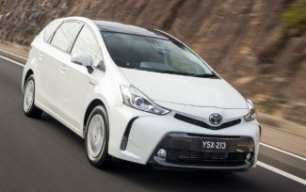The cabin of the Prius V highlights the notion of versatility. There are two rows of seats at the back, with the middle row sliding and folding to allow easy third-row access. And I mean easy - even me, a 183cm-tall human - can clamber into the back seats without too much in the way of old-man noises.
The space in the back row is limited, though, particularly for knee room and foot space. It is best left for children, then. But the second row has three individually slide-able seats, meaning if you really need to fit seven adults in, you theoretically could.
That second row is nicely useable. The fact the seats are sculpted individually means they feel made for a proper family getaway, and even with them set as far forward as they can go (to allow maximum legroom in the third row) I could sit in the outboard seats without much discomfort. The sun-blinds that are built into the back doors are a really welcome touch for parents and adults alike.
What isn’t so great is the lack of rear air-vents - there aren’t any face-level vents in either the second or third rows, meaning things could get stuffy on a hot day.
But the practicality side of things is reasonably well sorted, with useable cup holders in the rear wheel arch moulds, plus there’s a 12-volt outlet in the third row, too. The middle row has bottle holders in the doors, and there are map pockets in the front seatbacks.
Up front there is more smart storage; a pair (yep, two) of gloveboxes adorns the dashboard, and there’s a pop-out cupholder on the passenger side, too. Two more cupholders grace the centre console (which itself is very shallow, because the hybrid batteries sit inside it), plus a small storage box - presumably for your keys to sit. A small shelf sits at the bottom of the centre stack, and that’s where you’ll find a USB port to connect to the media screen above.
That 6.1-inch touchscreen is fine, but pretty ancient. It has some small menu buttons, won’t allow you to input phone numbers or connect to Bluetooth when the car is moving, and you (or your fellow front passenger) can’t manually enter sat nav details when you’re driving. There is voice control, but it’s painful. Forget Apple CarPlay and Android Auto, too - neither is available in the Prius V.
While the boot space is pretty limited with seven seats in place - Toyota claims 180 litres of capacity in that configuration - there’s still enough room for a suitcase or two.
But with five seats in play it makes quite a bit more sense, more easily fitting family things like prams with its 485L of cargo capacity. And remember, there are no batteries under the boot floor eating into space, and you get a space-saver spare wheel as well.




























